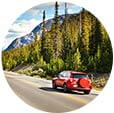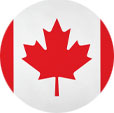In Canada, wildlife comfortably outnumbers people. With so many critters roaming the wilds, it may come as no surprise that Canada is home to 60% of the world’s entire bear population. Of all the outdoor activities that Canada offers, bear watching is one of the best and most rewarding experiences.
There are many opportunities to spot some native bears – particularly if you know where to look. Most people will only ever dream of getting up close and personal with these wild animals, but in many places in Canada, big bears are a part of everyday life. The three species of bears native to Canada are grizzlies, black bears and polar bears, but if you’re lucky you might spot some exciting subspecies, too.
If you’d like to go on holiday to Canada to see the bears for yourself, take a look at our wildlife holidays:
Click to jump to a section:
- What type of bears will I see in Canada?
- Where to see bears in Canada
- When is the bear season in Canada?
- What is the bear population in Canada?
- Bear safety
- Respecting bear communities
What type of bears will I see in Canada?
Grizzly (Brown) Bears

The North American brown bear, also nicknamed the ‘grizzly’, is frequently spotted in Canada’s North and on the West Coast. What distinguishes grizzly bear subspecies from other brown bears is geography – the brown bears of Eurasia are a different subspecies to their grizzled American counterparts. Coastal bears tend to be bigger than inland ones.
Some of the world’s most famous and revered bears, grizzlies or brown bears can be found across Western Canada. Individuals grow up to 700 kilograms, and although they have a diet mainly consisting of berries and plants, protein-rich foods like salmon are easily accessible along the coast. Grizzlies can be identified by the protruding hump on their shoulders and their shaggy – or grizzled – coat, which is lighter at the tips than at the root. Considered an endangered animal, seeing a grizzly or North American brown bear is a once-in-a-lifetime experience not to be missed.
Black bears

Males weigh up to 280 kilograms while the females are smaller, new-born cubs can weigh as little as 300g. These omnivorous creatures have adapted to living within the area’s alpine meadows and forests, but there’s no need to worry about these bears hiding in one place– some adult males, also known as boars, can cover up to 620 square miles in their lifetime.
Black bears are the most common bear family in Canada, however, more unusual subspecies can be found. According to Bear with Us, black bears can also be seen in different colour phases, such as brown and cinnamon. So, keep your eyes peeled for unusual variations, as you may be in for a very rare treat! In Canada, black bears hibernate from around October or November to around April, or whenever the snow melts. So, to maximise your chances of spotting them, visit outside of these months. Listen out for the cubs’ shrill howls and the adult bears’ woofs when you’re exploring the forests.
The Kermode or “spirit” bear
The Kermode, or “spirit” bear as it is known in First Nations folklore, is a rare subspecies of the black bear. The striking cream colouring of the Kermode bears helps them to survive, as they are less visible to fish than their black counterparts, making them more effective at hunting. Their white fur also makes it easier for visitors to spot within the forest. Today, fewer than 400 of the gentle bears exist, making them a highly desirable sight for any nature-lover on holiday in Canada.
Polar bears

This is not only the largest of all bear species in North America, but it is also the largest species in the world. Adult males can reach up to 800 kilograms, whereas adult females are smaller and weigh around 300 kilograms on average. Similar in build to grizzlies, polar bears are larger due to their carnivorous diet mainly made up of seals. November is a prime time to visit Canada to see polar bears, as the ‘big freeze’ in areas such as Churchill and Hudson Bay is well underway. At this time, polar bears are waiting around for the ice to freeze so they can hunt for seals, and visitors are able to see them in large groups.
Where to see bears in Canada
Where to see Grizzlies
is home to the Great Bear Rainforest – a maze of coastal inlets, islands and valleys which spans the coast from Knight Inlet to the Alaska Panhandle. They can also be found in Yukon, Alberta, the Northwest Territories and Nunavut. Primarily solitary animals, it is rare to see grizzly bears in groups, but exciting gatherings can be seen on an Alaskan cruise, where grizzlies hunt for salmon making their way upstream in the spawning season.
Tweedsmuir Provincial Park
The beautiful Tweedsmuir Provincial Park is British Columbia’s largest park and one of the best places to catch a glimpse of grizzlies. With 989,616 hectares to roam, brown bears often choose to congregate on the Bella Coola River to paw for salmon between May and October. The park is known for being an isolated wilderness, so we recommend exploring the province with a guide to ensure you are prepared if you encounter a visit from a four-legged resident.
The Chilcotin Mountains
Saddle up in the Chilcotin Mountains and join a horseback camping trip to look for brown bears wandering through the beautiful alpine meadows. These beautiful ranges in British Columbia are also home to the Spruce Lake Protected Area, a 71,000-hectare space that is famous for its alpine lakes and mountain peaks, encompassing the watersheds of Lizard and Leckie Creeks. The lakes are home to grizzlies and are well worth a visit in their own right.
The Cariboo Mountains
Alternatively, travel further east to the Cariboo mountain range. The Cariboo Mountains may be best known for their resident horses, but they also support a healthy grizzly population. Home to ‘bear whisperer’, Gary Zorn, here you can travel by boat down the glacial waters of the Mitchell River at Pyna-Tee-Ah Lodge in search of bears hunting for food along the shoreline.
Alaska
This huge wilderness is fittingly home to some huge bears – the largest subspecies of the North American brown bear, to be precise. The Kodiak bear lives exclusively within the islands of Alaska’s Kodiak Archipelago and is the heaviest brown bear. When standing fully upright on its hind legs, an average male could reach a height of 9.8 feet!
According to National Geographic, if you visit at the right time, you can witness one of nature’s finest spectacles. They say:
“Dramatic gatherings of grizzly bears can be seen at prime Alaskan fishing spots when the salmon run upstream for summer spawning. In this season, dozens of bears may gather to feast on the fish, craving fats that will sustain them through the long winter ahead.”
If you’re looking to see how grizzly bears interact in groups, and to see the famous ritual of salmon-fishing that only grizzlies can perform so skilfully, there is no better place to spot this species.
Glendale Cove
Phil from Grizzly Tours says Glendale Cove is one of the best places to see Grizzly Bears in Canada: “Spring and summer viewing is done in Glendale Cove from the comfort of small boats giving a “marine safari” style experience. During September and October, you can either view from boats or from our viewing platforms as this is when the salmon run starts on the Glendale River. For many guests seeing the bears fish for salmon is a lifelong goal but for others watching the bears in the spring as they forage along the shoreline is something they will never forget.”
Where to see black bears
Black bears reside in the forest regions of each province and territory throughout Canada besides Prince Edward Island. However, to get the best chance of seeing these unique animals up close, venture to the east or west coasts, particularly British Columbia and
Whistler, BC
A short drive from the Coast Mountains around Whistler is home to around 60 black bears and cubs, which can live up to 25 years in the wild. If you are staying in Whistler from mid-March to November, you have a huge range of wildlife tours to choose from. Local guides share their knowledge and take you in comfortable 4x4s to watch active bear dens, day beds and feeding sites. Find out the interesting facts and history of Whistler’s black bear population from those who have been working with bear communities for decades. By the end of the experience, there is no doubt that you will be a resident expert. If you prefer to watch these wild animals from the sky, ride in the longest and highest lift in the world, Whistler’s Peak2Peak gondola, and keep your eyes peeled for mother bears and their cubs foraging below.
Vancouver Island
If you can draw yourself away from orca watching, a trip to Vancouver Island is the perfect opportunity to spot black bears in the wild. This is the largest Pacific island east of New Zealand, and the largest on the west coast of North America, so there is plenty of space to see unique species. Featuring mountains, rugged shorelines, fjords, lakes and rivers, Vancouver Island offers a wealth of habitats for bears to choose from. But it is the dense interior forest that appeals to them the most. Interestingly, the black tone of the Vancouver Island bear’s coat is darker than that of the mainland individuals.
Joe from Walk My World thinks that the best place to see black bears is on Vancouver Island: “In our experience, the best place to see bears is Vancouver Island. British Columbia has the highest population of grizzlies in Canada and its own endemic species of Black bear. For a bucket list experience, head up to Alert Bay in the northern part of Vancouver Island, where you can hop on a tour to the world-famous Great Bear Rainforest. Here you can see wild grizzlies from the safety of your boat, with experienced indigenous tour guides. This area is also known for being a good place to see wild orcas.”
“If you want to see black bears in particular, then head to Tofino on the west coast of Vancouver Island. Here you can see these wild bears from a small zodiac boat as they wander the shores, turning over stones in search of crabs. If you are feeling really adventurous you can even take a kayaking trip which will get you even closer to the bears.”
Sharon from Travel, Eat, Enjoy, Repeat agrees with Joe that Vancouver Island is the ideal bear watching location:
“For bear watching, British Columbia is the place to be in Canada. And more specifically around Vancouver Island. From here, you can book a bear watching tour to the Great Bear Rainforest where you have the chance to not only see black bears but also grizzlies. And if you are very lucky the Kermode “spirit” bear. Our tour took us to Knight Inlet where we got to see a grizzly bear. But you also have chances to see bears along the way; like a mama bear and her cubs. Early in the morning, during low tide, is the perfect time to see them; they walk along the shore searching for food.
“From the water, you have a perfect view of the bears without disturbing them. It was so calming to see them flip over rocks, and just walk along the shore. You can really watch them all day.”
The Boreal Forest, Ontario
As the largest forest region in Canada, the Boreal Forest is notable not only for its fauna but also simply for its 50-million-hectare acreage. Extending from the Great Lakes of St. Lawrence to the Hudson Bar lowlands, the forest comprises 50% of Ontario’s area in coniferous and mixed-wood forests. Exploring the boreal forest, you will quickly learn of the dynamic pace of natural life here. Boreal forests often experience large forest fires, but rather than destroying the environment, these natural disturbances are regenerative. Jack pine and black spruce quickly regrow after the fires, creating a natural pattern of life. However, this can make survival more of a challenge for black bears. Due to less abundant food, black bears here can only produce litters every three or four years (usually every two years). But if you’re looking for stunning surroundings and are particularly interested in spotting cubs, this is the place for you, as young bears in the boreal forest grow more slowly than in other areas, according to Martyn E. Obbard.
What do black bears eat?
You might think that bears and black bears, in particular, would have a diet that consists of fish and meat, but surprisingly black bears are rather picky eaters and their diet mainly consists of grasses, roots, berries, and insects. They will eat mammals and fish on the occasion and can often find an appetite for bin rubbish and human garbage if found when wandering.
Bear Smart comments on their diet on their website: “Bears spend most of their time perusing a patchwork of habitats throughout the year, feeding on vegetation, insects and other more reliable, though lower-calorie food sources. Plant foods make up the majority of a bear’s diet – sometimes as much as 90 per cent.
“However, fish and meat are important sources of protein and fat, though most non-coastal bears rely on carrion (including winter-killed animals). Some bears, however, become very effective predators on new-born elk, moose, deer or caribou. Others live in areas where salmon, suckers or other fish spawn for part of each year.”
Where to see the spirit bear

Writing for The Telegraph, Mark Carwardine explains that to see the Kermode bear, also known as the spirit bear: “First, you have to go to the right area, which can only be reached by boat or floatplane (the Great Bear Rainforest is a true wilderness, with no trains and no real roads). And that’s an adventure in itself.” However, there are communities of spirit bears also residing on Princess Royal Island, so you can choose which area appeals to you the most. Visit in September to see the spirit bear, as they spend the winter hibernating deep in the tangled forest, only venturing into the open in autumn to feast on the salmon in creeks and rivers.
Princess Royal Island, the Great Bear Rainforest
The ideal location to watch and capture spirit bears on camera is the large Princess Royal Island just 500km north of Vancouver where there are reported to be around 120 of these rare creatures – the highest concentration in the world. For the ultimate Kermode bear-watching experience, visit the Great Bear Rainforest on the coast of British Columbia, between Vancouver Island and South East Alaska. This is one of the largest remaining tracts of unspoilt rainforest left in the world and is sometimes called the ‘Amazon of the North’. This 21-million-acre wilderness encompasses 1,000-year-old cedar forests with waterfalls flowing down the sides of moss-covered mountains, making it the ideal home for a variety of Canadian wildlife. The best time to visit is from late August to October when thousands of returning salmon draw the elusive Kermode bear as well as grizzlies to the rivers.
When is the bear season in Canada?
To see the famous polar bear, venture north. Polar bears thrive in cold, icy environments, like the Canadian Arctic. You might have to wrap up, but the cold is well worth it when you see these rare and majestic animals in the flesh. Visit Canada in the autumn season for the best chances of seeing a polar bear. Read our article about bear watching in Canada to find out more about where and how to see these incredible creatures.
Churchill, Manitoba
Undoubtedly the best place in Canada to see polar bears is Manitoba, an area famous for their presence. Between October and November, the polar bears head to Hudson Bay to begin their migration from their summer habitat in the icy tundra back to the pack-ice, ready to hunt for seals. This is the best time to spot polar bears in Canada. However, they can still be sighted on the tundra itself in winter or wandering around coastal rocks in the summer.
Wapsuk National Park, Manitoba
If you love photographs of adorable polar bear cubs as much as we do, then you will want to add Wapsuk National Park to your bucket list. Here, during late February, you could just be lucky enough to see mother polar bears and their young cubs with your own eyes as they emerge periodically from their protective dens. In this wild area made up of subarctic forest, muskeg and tundra, humans rarely venture out – and when they do, it is solely to see these polar bears’ maternal bonding moments. This is a must for lovers of baby polar bears, as you could see cubs as young as three months old!
What is the bear population in Canada?
The exact number of bears in total across Canada is not known, but the best place to find grizzlies is in British Columbia, where around between 10,000 and 20,000 of these impressive animals live – over half of Canada’s grizzly population.
The black bear is the smallest of the Canadian bears and more than 380,000 live in Canada. They typically reside in forests, although they can also be found in the mountains and on the coast.
Bear safety

As omnivores who eat fish and plants, bears are generally uninterested in humans. As a general rule, black bears are perfectly safe as long as they are not threatened. Grizzlies tend to be more aggressive, however, and a close encounter with one of these is more serious. As many bear watching tours operate using vehicles and boats, you can see them from a safe distance. However, as with any large mammal, there are several bear safety measures you should consider when experiencing these powerful animals:
- Never feed or approach bears.
- Reduce or eliminate odours that attract bears.
- Bear-proof food storage bins must be used if they are available at a national or provincial park.
- Store garbage with your food, out of reach of bears and in bear-proof containers. Do not bury garbage or throw it into pit toilets.
- If you are camping, cook and eat well away from your tent.
- Clean up immediately and thoroughly after cooking.
- The odours of cosmetics, toothpaste and insect repellent can attract bears, so store these out of reach with your food and rubbish.
- Obey all closures and warnings.
- Stay clear of dead wildlife.
- Check ahead for bears in the distance and avoid them.
- Check for signs such as tracks, droppings, overturned rocks, rotten trees torn apart, clawed, bitten or rubbed trees, bear trails, fresh diggings or trampled vegetation.
- Make noise when you are hiking through remote areas by talking, singing, banging etc. so that bears are aware of your presence and you don’t startle any.
In the extremely unlikely event that you come into close contact with a bear, stay calm. Talk slowly and firmly to the bear, holding your arms up, whilst backing slowly away. Never run from a bear. Click here for more information on bear safety.
Respecting bear communities
As British Columbia Parks state, “A fed bear is a dead bear.” When encountering any kind of bear in the world, ensure you are not carrying food and never feed them. They explain:
“Bears that scavenge food begin to associate food with humans and become “food-conditioned.” Food-conditioned bears lose their natural fear of humans and become a threat to park visitors as they roam through the park in search of an easy meal.” These bears will then have to be removed by park rangers. So, for the bears’ safety as well as your own, never give food to individuals you may come across.

Ready for your own bear watching adventure? We’ve got lots of fantastic packages to choose from which include bear watching trips in Canada’s pristine wilderness. If you’re ready to book, take a look at our flights to Canada and start planning your bear-watching adventure today.








